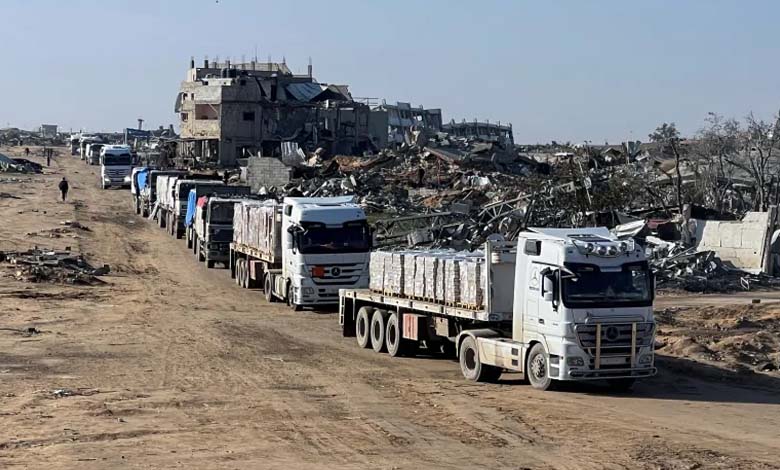Investigating Hamas: Signs of a New Mechanism to Deliver Aid to Gaza

Amid UN warnings of imminent food shortages in Gaza, the United States and Israel are nearing an agreement on how to resume the delivery of humanitarian aid to Palestinians without allowing Hamas to control it.
-
At Risk of Sinking: Drone Attack on Ship Carrying Aid to Gaza
-
Washington will vote on a revised resolution to introduce aid to Gaza
According to Axios, citing Israeli officials and a U.S. source familiar with the plan, the new aid delivery system “will weaken Hamas by depriving it of revenue and reducing the population’s dependence on the group.”
Israeli officials claim that during and before the ceasefire, Hamas managed to take control of most of the aid entering Gaza. It allegedly sold some of the aid and used millions of dollars in proceeds to pay its military wing, while distributing aid to civilians to maintain its governance over Gaza.
-
US-Emirati talks to open humanitarian corridors for aid to Gaza
-
Israeli Plan to ‘Control’ Gaza Aid Raises Humanitarian Concerns
A New Mechanism
In recent weeks, Israeli and U.S. officials, along with representatives of an international humanitarian organization and private companies, have been discussing a new aid delivery mechanism. On the Israeli side, the effort has been led by Strategic Affairs Minister Ron Dermer.
Israeli officials said Prime Minister Netanyahu briefed Donald Trump on the talks during a phone call last week. Speaking aboard Air Force One on Sunday, Trump told Netanyahu: “You have to be kind to Gaza. These people are suffering. They urgently need food and medicine, and we are taking care of it.”
-
The Weapon of Hunger: Netanyahu Threatens Gaza with an Even Greater Humanitarian Catastrophe after Halting Aid
-
Gazans Call for Aid to Combat Homelessness
A source familiar with the plan told Axios that the new mechanism will meet Trump’s objective of allowing humanitarian aid into Gaza while adhering to the Israeli cabinet’s directive that no aid should reach Hamas.
A U.S. State Department official described the new system as “something worth celebrating.” It resulted from discussions between Israel and aid institutions, with backing and approval from the Trump administration.
-
Israel Plans to Use an American Security Firm to Distribute Aid in Gaza
-
Caravan of Hope… UAE Aid reaches Gaza for the first time since Rafah crossing closure
“We are confident that the mechanism will deliver aid to those who need it, consistent with our principles: we support humanitarian flows with safeguards to prevent diversion, theft, or misuse by terrorist groups like Hamas or Palestinian Islamic Jihad,” the official stated.
“President Trump and Secretary of State Marco Rubio expect all UN agencies and international aid organizations to operate within this mechanism to ensure Hamas has no access to these vital resources,” he added.
Under the plan being negotiated, aid operations in Gaza would be directed by an internationally governed organization, managed by humanitarian professionals and advised by a board of prominent international figures.
-
UNRWA: “Looting” Operations Hamper Aid Delivery in Gaza
-
Euronews: Humanitarian Aid Reaches Gaza, Desperation Grips Palestinians
Several aid hubs will be built in parts of Gaza, where Palestinian civilians can go once a week to receive a package of aid per family, enough for seven days.
Israel has committed to funding and implementing the massive engineering work needed to construct secure aid distribution facilities. Discussions are underway with donor countries to finance the organization’s operations, including aid procurement.
A private U.S. company will be responsible for logistics and for providing security inside and around the humanitarian hubs. Israeli forces will not participate in aid distribution nor be present in the hubs but will ensure security in the surrounding areas.
-
Thousands in Gaza Face Famine as Aid Trucks Line Up in Egypt on Eid
-
Gaza Aid Shifts Allies’ Compass… France Criticizes Israel and Warns
When Will It Be Ready?
According to Israeli officials, they aim for the mechanism to be operational before the Israeli army expands its ground operation in Gaza—expected later this month if hostage and ceasefire negotiations remain stalled.
The Israeli security cabinet is scheduled to meet Sunday to approve the mobilization of more reserve forces and expansion plans for the ground operation.
U.S. and Israeli officials also want the mechanism ready when Trump visits the region in two weeks. He is expected to visit Saudi Arabia on May 13, then head to Qatar and the UAE. He is not currently expected to visit Israel.
-
Ghost of famine looms over Gaza amid aid shortages
-
48 Hours… Hamas Sets Deadline to Respond to Gaza Truce Proposal
After the collapse of the Gaza ceasefire two months ago, Israel halted all humanitarian aid shipments of food, water, and medicine to the Strip, worsening the humanitarian crisis.
UN relief agencies say food supplies in Gaza will run out within days, while Israeli officials estimate full depletion in three to four weeks.
The suspension of aid and renewed Israeli strikes have displaced thousands of Palestinian civilians, deepening the chaos in Gaza and triggering widespread looting and lawlessness.
On Sunday, President Trump said he had pressured Israeli Prime Minister Netanyahu to allow food and medicine into the devastated Gaza Strip.












